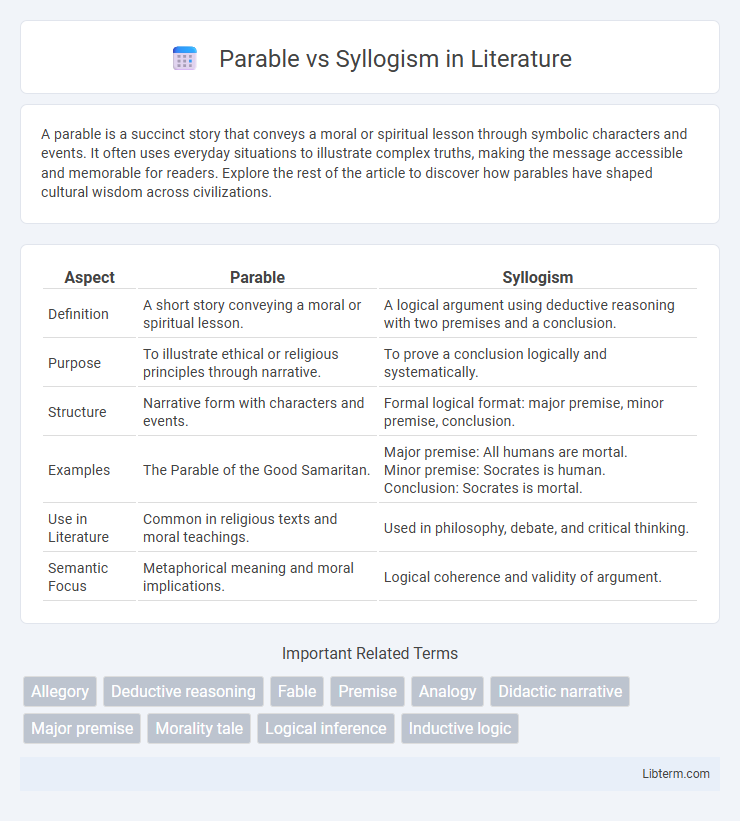A parable is a succinct story that conveys a moral or spiritual lesson through symbolic characters and events. It often uses everyday situations to illustrate complex truths, making the message accessible and memorable for readers. Explore the rest of the article to discover how parables have shaped cultural wisdom across civilizations.
Table of Comparison
| Aspect | Parable | Syllogism |
|---|---|---|
| Definition | A short story conveying a moral or spiritual lesson. | A logical argument using deductive reasoning with two premises and a conclusion. |
| Purpose | To illustrate ethical or religious principles through narrative. | To prove a conclusion logically and systematically. |
| Structure | Narrative form with characters and events. | Formal logical format: major premise, minor premise, conclusion. |
| Examples | The Parable of the Good Samaritan. | Major premise: All humans are mortal. Minor premise: Socrates is human. Conclusion: Socrates is mortal. |
| Use in Literature | Common in religious texts and moral teachings. | Used in philosophy, debate, and critical thinking. |
| Semantic Focus | Metaphorical meaning and moral implications. | Logical coherence and validity of argument. |
Understanding Parable: Definition and Purpose
A parable is a simple story used to illustrate a moral or spiritual lesson, often found in religious and philosophical contexts. Unlike a syllogism, which relies on formal logical structure to derive conclusions from premises, a parable uses narrative and metaphor to engage emotions and provoke reflection. Its purpose is to convey complex truths through relatable scenarios, making abstract ideas more accessible and memorable.
What is a Syllogism? Key Features Explained
A syllogism is a form of logical reasoning consisting of two premises leading to a conclusion, structured to deduce truth from given statements. Key features of a syllogism include a major premise, a minor premise, and a conclusion, all sharing a common term that links the premises together. This method is widely used in formal logic and philosophy to demonstrate valid arguments through deductive reasoning.
Historical Origins: Parable and Syllogism
Parables, rooted in ancient storytelling traditions, date back to early religious and philosophical texts, notably within Judaic and Christian teachings, where they served as illustrative moral lessons. Syllogisms originate from classical Greek philosophy, primarily formalized by Aristotle in the 4th century BCE as a foundational method of deductive reasoning in logic. Both forms emerged to convey knowledge: parables through narrative analogy, and syllogisms through structured argumentation.
Structure of a Parable vs Structure of a Syllogism
A parable features a narrative structure with characters, settings, and events designed to convey a moral or lesson through analogy, often leaving interpretation open-ended. In contrast, a syllogism presents a formal, logical framework consisting of two premises followed by a conclusion, which strictly follows deductive reasoning rules. While parables rely on storytelling to illustrate abstract truths implicitly, syllogisms explicitly demonstrate relationships between statements for clarity and validity in arguments.
Narrative vs Logic: Fundamental Differences
Parables use narrative storytelling to convey moral or spiritual lessons through relatable characters and events, creating an intuitive understanding rooted in experience. Syllogisms rely on formal logic, using structured premises to derive a conclusion through deductive reasoning, emphasizing clarity and precision. The fundamental difference lies in parables appealing to emotional and imaginative faculties, while syllogisms engage analytical and rational thought processes.
Applications in Literature and Philosophy
Parables, as narrative tools, effectively illustrate moral or spiritual lessons through relatable stories, making complex philosophical concepts accessible in literature and religious texts. Syllogisms, structured as formal logical arguments, are primarily employed in philosophy to rigorously analyze and deduce conclusions from premises, enhancing critical thinking and reasoned debate. Both methods enrich philosophical discourse: parables engage imagination and ethical reflection, while syllogisms facilitate clarity and systematic reasoning.
Cognitive Impact: How We Learn from Parables and Syllogisms
Parables engage the brain through storytelling, creating emotional connections and vivid imagery that enhance memory retention and moral understanding. Syllogisms utilize logical structures, promoting analytical thinking by linking premises to reach conclusions through deductive reasoning. Both methods complement cognitive learning by balancing intuitive insight with systematic evaluation.
Examples of Parables and Syllogisms in Practice
Parables, such as the Biblical "Parable of the Good Samaritan," use narrative to convey moral lessons through relatable scenarios, while syllogisms employ logical structures like "All humans are mortal; Socrates is human; therefore, Socrates is mortal" to demonstrate deductive reasoning. In educational settings, parables engage students by illustrating ethical principles through storytelling, whereas syllogisms strengthen critical thinking by training students to analyze arguments based on premises and conclusions. Both tools serve distinct purposes: parables evoke reflection through analogy, and syllogisms provide clarity through formal logic.
Strengths and Limitations of Each Method
Parables excel in conveying complex moral lessons through relatable stories, making abstract concepts accessible and memorable but often lack precise logical rigor and can be interpreted subjectively. Syllogisms provide clear, structured arguments with definitive conclusions based on premises, ensuring logical consistency yet may oversimplify nuanced ideas and fail to engage emotional or ethical dimensions. The strength of parables lies in their narrative power to influence values, whereas syllogisms strengthen analytical reasoning by emphasizing valid inference patterns.
Choosing Between Parable and Syllogism for Effective Communication
Choosing between a parable and a syllogism depends on the communication goal and audience understanding. Parables use storytelling to illustrate moral or spiritual lessons, enhancing emotional engagement and relatability. Syllogisms rely on logical structure and deductive reasoning, making them effective for presenting clear, rational arguments in analytical or academic contexts.
Parable Infographic

 libterm.com
libterm.com